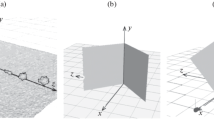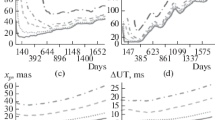Abstract
This article considers the solution of the problem of recognizing the artifacts of the Sun and the Moon in the signal of the photodetector (PD) of the Earth’s orientation device. The previously developed machine learning model, trained on clean signals (real and generated), must be tested for robustness (stability) to real signals that can be noisy and the model should be corrected if necessary. The stability of the machine learning model to noisy signals is studied, and a decrease in the quality of the classifier of normal and artifact signals of the PD of the Earth’s orientation device is revealed. To correct the model, the method of augmenting the initial data using artificially noisy signals is used, the types of noise characteristic of electronics (thermal-, shot-, and flicker-noise) are selected, and the levels of the signal-to-noise ratio (SNR) for devices of this class are selected. Methods for generating noise signals are selected and algorithms for the correct mixing of clean signals with noise are developed. The shortcomings of the existing linear model, which appear only when using different levels of the SNR, are revealed. The linear model’s errors turn out to be significant for the application area. A new classifier model based on decision trees is selected. The new model’s stability is also tested, and the need to expand the range of the SNR for the training sample is shown. The applied method of classifying artifacts and increasing the stability of the model can be used in PDs if it is necessary to provide built-in signal processing in its computing core of the device.





Similar content being viewed by others
REFERENCES
W. Zhao, C. Hua, D. Dong, and H. Ouyang, “A novel method for identifying crack and shaft misalignment faults in rotor systems under noisy environments based on CNN,” Sensors 19, 5158 (2019). https://doi.org/10.3390/s19235158
A. Pervaiz, F. Hussain, H. Israr, M. A. Tahir, F. R. Raja, N. K. Baloch, F. Ishmanov, and Y. B. Zikria, “Incorporating noise robustness in speech command recognition by noise augmentation of training data,” Sensors 20, 2326 (2020). https://doi.org/10.3390/s20082326
K. A. Grebenyuk, “Main types of noises in electronic semiconductor devices,” Izv. Sarat. Univ. Nov. Ser. Ser. Fiz. 12, 63–65 (2012). https://doi.org/10.18500/1817-3020-2012-12-1-63-65
R. R. Bikkenin and M. N. Chesnokov, Electrical Communication Theory: A Textbook (Akademiya, Moscow, 2010) [in Russian].
R. Watson and O. Downey, The Little Red Book of Acoustics: A Practical Guide, 3rd ed. (Blue Tree Acoustics, Sheffield, United Kingdom, 2013).
V. N. Nazarov and I. F. Balashov, Energy Evaluation of Pulse Laser Rangefinders (S.-Peterb. Gos. Univ. Inf. Tekhnol., Mekh. Opt., St. Petersburg). https://de.ifmo.ru/bk_netra/page.php?tutindex=27
J. Timmer and M. König, “On generating power law noise,” Astron. Astrophys. 300, 707–710 (1995).
X. Zhang, Z. Liu, J. Jiang, K, Liu, X. Fan, B. Yang, M. Peng, G. Chen, and T. Liu, “Data augmentation of optical time series signals for small samples,” Appl. Opt. 59, 8848–8855 (2020). https://doi.org/10.1364/AO.404799
I. Tam, M. Kalech, L. Rokach, E. Madar, J. Bortman, and R. Klein, “Probability-based algorithm for bearing diagnosis with untrained spall sizes,” Sensors 20, 1298 (2020). https://doi.org/10.3390/s20051298
T. Hastie, R. Tibshirani, and J. Friedman, The Elements of Statistical Learning: Data Mining, Inference, and Prediction, 2nd ed. (Springer, New York, 2009). https://doi.org/10.1007/978-0-387-84858-7
P. Lipinski, E. Brzychczy, and R. Zimroz, “Decision tree-based classification for planetary gearboxes’ condition monitoring with the use of vibration data in multidimensional symptom space,” Sensors, 20, 5979 (2020). https://doi.org/10.3390/s20215979
Funding
The works whose results are presented in this article were carried out based on Southern Federal University together with OAO NPP Kvant Space Instrumentation as part of the project “Development and creation of innovative bench equipment and high-tech production of a radiation-resistant small device for the orientation of spacecraft to the Earth of a secant type based on electronic components of domestic production” according to decree no. 218 of the Russian Government “On measures of state support for the development of cooperation between Russian higher educational institutions and organizations implementing complex projects on the creation of high-tech production” dated April 9, 2010.
Author information
Authors and Affiliations
Corresponding authors
Ethics declarations
The authors declare that they have no conflicts of interest.
Rights and permissions
About this article
Cite this article
Sinyutin, S.A., Sinyutin, E.S. & Yartsev, A.V. Research on the Stability of a Machine Learning Model for Processing a Signal of the Earth’s Orientation Device. Math Models Comput Simul 15, 1052–1058 (2023). https://doi.org/10.1134/S2070048223060169
Received:
Revised:
Accepted:
Published:
Issue Date:
DOI: https://doi.org/10.1134/S2070048223060169




